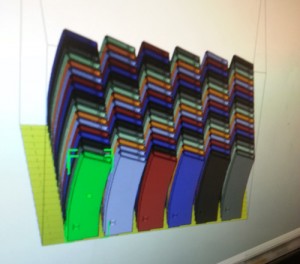
CAD files of high capacity ammunition magazines ready to be printed.
Latest News
January 16, 2013
Additive manufacturing (AM) is an amazing technology with vast potential. But there’s always a fly in the ointment. In the case of AM, I believe the fly can be named as 3D printed guns and peripherals. Rapid Ready has covered the battles between the gun enthusiasts that want to use AM, and the general sense of unease the industry has with this idea.
As I’ve stated before, the problem isn’t specifically the guns or peripherals, it is the potential for regulations to cripple AM just as it hits its stride. Nor is this idle speculation. U.S. House Rep. Steve Israel specifically cited 3D printing as a method of obtaining plastic firearms in his appeal for a renewal of the Undetectable Firearms Act.
Regardless of what Rep. Israel may believe, neither I, nor any other reputable researcher, has been able to find any proof that a fully plastic firearm is feasible. Certainly AM can be used to create parts of firearms, but the same can be said of other manufacturing methods. What AM can do is build high-capacity clips, like those banned in many states.
A group based in Texas, called Defense Distributed, has succeeded in using a home 3D printer to build a high-capacity clip. According to the group, they were able to fire 86 shots from the 30 round clip during a test. Given that CAD files can be easily distributed via the Internet, an outright ban on the sale high capacity clips won’t keep them out of the hands of determined civilians. Defense Distributed has even set up its own file sharing network to make finding the designs easier.
This is the sort of thing that could end up with digital rights management (DRM) “protection” becoming mandatory on all privately owned 3D printers. As I’ve previously reported, DRM is more of a Band-Aid than an actual solution to these kinds of issues. Hackers routinely bypass DRM on software and music, and there’s no reason to think it would prove any more effective on AM systems.
I believe the real test of AM and printed firearms or peripherals is yet to come. As amazing as we find current generation 3D printers, I’m sure they’ll eventually be looked upon as the punch card computers of yesterday. What will happen when home users are able to print in metal? The democratization of manufacturing could come to a screeching halt over fear of possibility.
Below you’ll find a video demonstration of the 3D printed magazine.
Source: Forbes
Subscribe to our FREE magazine, FREE email newsletters or both!
Latest News
About the Author
John NewmanJohn Newman is a Digital Engineering contributor who focuses on 3D printing. Contact him via [email protected] and read his posts on Rapid Ready Technology.
Follow DE






